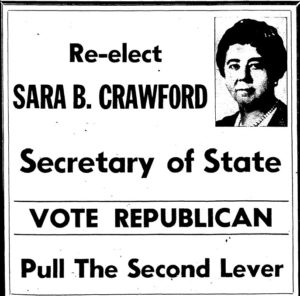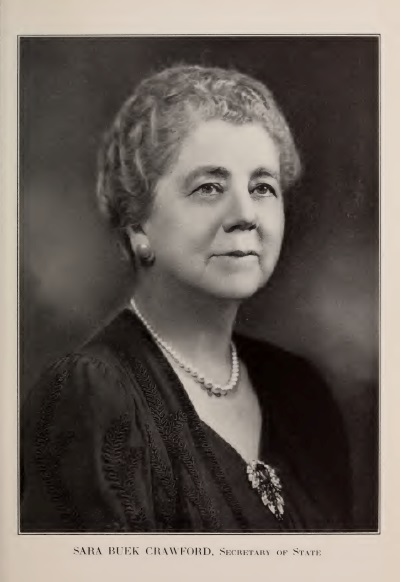By Kathleen Motes Bennewitz
Born in New York City on November 2, 1876—the nation’s centennial year—Sara Augusta Buek Crawford described herself a “typical woman.” In 1912, this daughter, wife, and mother ventured out from her parlor to campaign for “Votes for Women” with the Connecticut Woman Suffrage Association (CWSA) in Westport and across the state. In the fall of 1920, with the 19th Amendment now federal law, Crawford, like many women across the country, cast her first-ever ballot for president. This was just one of many firsts that this far-from-ordinary woman accomplished.
Connecticut’s First Female Secretary of State
In 1924, Sara Crawford made local history when she won at the polls as the first female state representative for Westport, a seat she filled for six terms (1925-1927; 1931-1937). More momentous, in 1938, she entered the state annals as the first female statewide elected official and first female Secretary of State (1939-41). Moments after being sworn in on January 4, 1939, Secretary of State Crawford made history again as the first woman delivering the oath of office to a Connecticut governor (Raymond E. Baldwin-R). In her 1940 re-election campaign, Chase Going Woodhouse (D) wrote to Crawford—her friend and political opponent—to express admiration: “Having worked toward the goal of women’s participation in our economic and political life, I have always had deep gratitude to women like you who pioneer and open new roads for the rest of us.”
Fueling her aspirations was the Buek family’s ambition and appreciation for the right to vote. Sara was the fourth of five children born to Charles and Sarah Rafferty Buek. Her mother was of Irish American heritage, and her father a German emigrant, who in 1847, had arrived in America with his parents and sisters. In 1861, a sixteen-year-old Charles enlisted with the 41st New York Volunteer Infantry to fight in the Civil War. Branded the DeKalb Zouaves, the regiment was comprised of German men recruited from New York City.
After the war, Charles married and set his sights on providing for his growing family by embarking on an architectural career amidst the post-Civil War building boom of New York City. In 1879, he founded Charles Buek & Co., operating as both architect and developer. As a real estate entrepreneur, he built upscale residences on the Upper East Side and in 1887 expanded the firm’s focus to speculative residential Upper West Side projects. By then, the now-affluent Buek family began summering in Westport.
Progressive Ideals Re-invigorate Westport
In the ensuing years, local farmers, merchants, and seafaring captains noticed growing numbers of artists, writers, publishers, actors, and career-minded women among their new neighbors. These newcomers, much like the Bueks, brought with them progressive ideas from experiences and careers in New York, Philadelphia, Chicago, and Europe. By 1904, women had a civics club of their own and in 1907 the Westport Town Improvement Association (WTIA; today’s Westport Woman’s Club).
In 1899, Sara Buek married John Crawford, and in 1907 the couple made Westport their year-round residence. Sara thrived raising her three daughters and being in the public realm. She ardently supported the WTIA and served as its president (1919-1924; 1929-1931), instilling a broader vision and more aggressive stance to move the women’s club beyond its original mission to “improve” the town. Although WTIA founder Mary Coley Staples claimed the organization “had no special interest in woman’s suffrage,” many members aligned with the Westport Equal Franchise League (WEFL), established in March 1912.

Re-elect Sara Crawford for Secretary of State advertisement – Stamford Daily Advocate, November 1, 1940
Crawford was among the charter members of the CWSA affiliate, although not a “militant suffragette” she admitted later. She aided the WEFL’s membership growth from twelve in 1912 to an organized body of fifty by 1914 and helped plan meetings and events with speeches carrying sharp, rallying messages—”The Necessity of a Mother’s Vote,” “Taxation without Representation,” and “The Wage-Earning Woman.”
Such forays into civic activism offered women a new-found political voice and platform. Once women had the vote, Crawford joined the Republican party and League of Women Voters and helped educate new voters on the machinery of government and dynamics of voting. In September 1920, she caucused for Westport’s municipal slate. She became president of the Westport Republican Women’s Club for eight years and vice chairman of the Republican Town Committee for twelve years. Upon being named the Republican nominee for Connecticut Secretary of State, she sought to represent “women of all parties who have been interested in the progress of women in public life” and those devoted to “the cause of good government.”
Recognizing her political prowess and appeal, in 1924 the Westport G.O.P nominated Crawford to run for the Connecticut General Assembly; she was elected state representative in a Republican landslide. The 1925 House included twenty-two women, about one-quarter of the seats; of these, seven represented Fairfield County, historically a pro-suffrage stronghold. The path to Crawford’s own notable local victory had been primed in 1922 by Ann Boylan Wright (D), a fellow WEFL and WTIA member and the wife of illustrator George Hand Wright.
Reaching the Next Generation of Women
As a suffragist and pioneering legislator, Crawford embraced her role as an archetype to the next generation of Connecticut women. Throughout her political career, she spoke on the impact of a woman’s vote, reinforcing the 1917 clarion call of fellow Westport suffragist Amelia Cutler: “Votes talk, votes count, votes compel respect, votes decide every question.”
Two months into her inaugural Hartford session, Crawford spoke to the Norwalk Republican Women’s Association on her impressions as a female legislator. Her words were also intended to inspire Norwalk to send a woman representative to the 1927 General Assembly:
Entering into and finding one’s place in the work of the Legislature is interesting . . . and the women appreciated their opportunity to the fullest extent. . . . Women are still subject to much criticism and close scrutiny, but the most efficient woman must prove her efficiency while a least efficient man is so often taken on his trust. Select the woman most fitted for the position and make a strong case for her. But do not support a woman for her sex alone.
Among those following in her footsteps was her second daughter, Sara Crawford Maschal. In 1938, she was elected Norwalk’s first female state representative (R) and extolled for being the first daughter to follow a mother to the state house.
In a 1940 interview, Secretary of State Crawford was asked if Connecticut would ever have a woman governor, to which she replied: “It might happen anytime. You know Connecticut has been very progressive in its attitude towards women in public office.” That finally came to fruition in 1975, twenty-six years after Sara Buek Crawford’s death, when Ella Grasso (D) became the 83rd Governor of Connecticut.
Kathleen Motes Bennewitz serves as Westport’s town curator and helps manage the Westport Public Art Collections. She has worked for art and historical museums across the country and today is an independent American art historian and exhibition curator.










